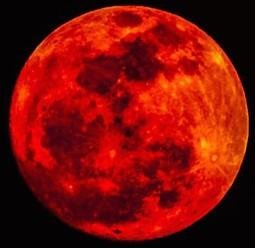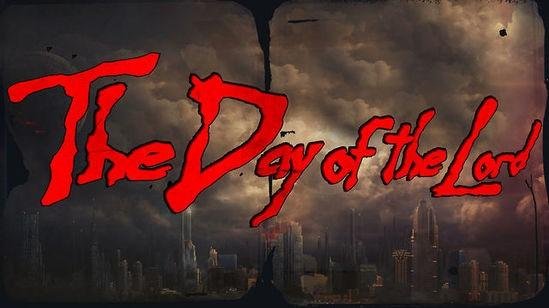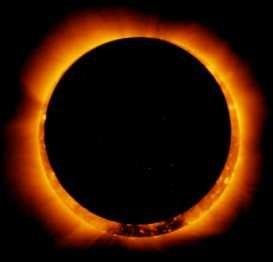Daily celestial challenge -blood moon

People often wonder why I discourage personal Bible reading when you have no prior training or present community to keep you on track. Case in point: "End of the World" predictions tied to blood moons that happen on Jewish holidays. When you have a Bible to quote but have not the Bible study skills to interpret it, you are a danger to yourself and everyone else. Every author, tv personality, and blogger predicting the imminent "Day of the Lord" fits that bill. They represent a 1500-year old line of apocalyptic prophets who quoted Bible verses but didn't know what they meant in the first place. The latest manifestation is turning astronomical imagery in Joel 2:31 and Revelation 6:12-17 into a cosmic signal of Judgment Day.
Doomsday Discussions with Faulty Assumptions
The misinformed doomsday scenarios have been propagated by celebrity preachers John Hagee (see his book Four Blood Moons) and Mark Blitz (who claims to be the first discoverer of the anomaly in Blood Moons: Decoding the Imminent Heavenly Signs). Youtube, social media, and now mainstream news outlets have made the theory go viral. Its popularity has created a new class of "Biblical conspiracy theorists." The only results in my estimation have been: (1) increased product sales for televangelists and (2) confused Christians who want to know if any of it is "biblical."
Online apologists have tried to respond by saying, "the fact of eclipses, while interesting, is no proof that Jesus will return by 2015." However, these thoughtful responses still think the darkening sun, bloody moon, and falling stars are some type of astronomical event that will signify the return of Jesus. Both the theorists and apologists use the same modern assumptions to miss the meaning delivered in ancient cosmological metaphors.
So let's get a better "biblical" foundation on which to build. Let's make clear what Joel 2:31 and Revelation 6:12-17 are actually predicting in human history.
"The sun will be turned into darkness and the moon into blood
Before the great and awesome day of the Lord comes." - Joel 2:31
The book of Joel actually predicts the sun, moon, and stars will lose their brightness 3 different times (Joel 2:10-11, 2:30-31 & Joel 3:15-16). If you read the prophecy chronologically, it would make no sense. The lights would be going on and off a lot. So what is going on in Joel's prophecy?
The book of Joel is a conditional prophecy to Israel. That means Israel's future depends on their response to the prophetic message. Israel has suffered from a plague and a famine (read chapter one) and faces a prophetic warning about an army coming if they don't repent. If they do repent, God says he might bless them instead of destroy them (Joel 2:12-14). The latter half of Joel 2 and all of Joel 3 describes how blessed God's people could be in the land if they choose to be faithful to Him.
Sun and Moon Are Signs of Stability
In both scenarios of Joel 2-3, the world as Israel has experienced it will be changed. It could drastically change for the worse or the better. That is why Joel uses the astronomical references to the sun and moon. As Genesis 1 states, "the big light (the "sun") was for the day and the lesser light (the "moon") was for the night." These bright lights in the sky gave order to the world. The sun and moon were "signs for the seasons and days and nights" (Gen 1:14). They were the grand pillars of stability.
To predict the sun going dark (solar eclipse) or the moon turning reddish orange (lunar eclipse) is to predict a significant change in the current course of history. Life will not go on day in and day out as before. It designates a break from the norm. The status quo will be shaken up.

The Day of the Lord is Not What You Think
Most Bible readers get confused here. Since these cosmic anomalies coincide with a “great and awesome Day of the Lord,” we assume the end of the world. But that only reflects a limited understanding of the Ancient Near Eastern phrase “Day of the Lord.” Any great military leader, king, or god can have a “great Day.” When an ancient commander had a decisive victory in battle, it could be called a “Day of that commander.” The phrase is used this way in the Bible and outside the Bible. So the “Day of the Lord” is a reference to any decisive judgment from God either against Israel or her enemies. The Assyrian and Babylonian invasions of Israel were “days of the Lord.”
In this cultural context, Joel 2:28 is simply a prediction of a turning point in Israel’s history. God is going to step in and judge. They may be judged favorably and receive a blessing or unfavorably and endure greater punishment. The turning point, or Day of the Lord, will be so significant that Joel uses language of solar and lunar eclipses. He wants people to know that life in Israel won’t keep ticking as it is now. Even as the stable sky lights can sometimes go dark, so can the life Israel knows unexpectedly change.
"The sun became black and the whole moon became like blood and the stars of the sky fell to the earth. For the great day of their wrath has come."

Revelation 6:12-17 adds "falling stars" to the lunar and solar eclipses to emphasize how the status quo is about to change. Why? Stars were used to track the time of year. Locations of planets and constellations told ancient observers which season they were in. It gave land and sea travelers their bearing. To take that away means the world is out of control.
John's vision of "falling stars" alongside a lunar and solar eclipse is symbolic like other imagery in John's Apocalypse. Just like the horses in the beginning of Revelation 6 and the scorpions in Revelation 9, the imagery is designed to deliver a symbolic message. Revelation 6 isn't predicting 4 horses will actually ride into Israel nor is Revelation 9 concerned about an invasion of scorpions. Revelation 6:12-17 is likewise not concerned about all the visible stars in the universe crashing into planet earth or the hydrogen fueled flames of the sun burning out.
The lights in the sky represent the stable order of everyday life. The imagery is symbolic and the meaning is simple: the current status quo in Israel is about to change through significant historical events. That is how symbolic language works in apocalyptic literature, whether you are interpreting John's Apocalypse or the contemporary Jewish Apocalypses of Enoch or Ezra. When you don't know how the language works, you create baseless theories about the end of the world and get moderate responses from equally uninformed conversation partners.
So How Do We Interpret Blood Moon Prophecies?
The significant historical changes evoked by Joel and John's prophetic imagery of eclipses had nothing to do with the end of the world. Joel's conditional prophecy to Israel meant their time of famine would become extreme agricultural fruitfulness if they repented. Times of oppression by foreign powers would turn into national independence. That's how the world of suffering Israel knew in Joel 1 would be changed into the blessed world of Joel 3. That's the great historical change of fortune that the eclipses symbolized.
The Apocalypse of John describes an entirely different way God stepped into history to judge. Revelation 6 uses 4 horsemen to symbolize the suffering that ancient Israelites endured when Jerusalem was besieged. War, price gouging, food scarcity, and death all followed. The "Day of the Lord" (or great military feat) orchestrated by God in Revelation 6 was the Roman destruction of Jerusalem during the siege in 70 AD. The "great day of their wrath" (Rev 6:17) was the massive slaughter of Israelites who rebelled against Rome. God orchestrated the events to punish those Israelites who rejected Him by killing His people, prophets, and Messiah (see Rev 6:9-11). The destruction of Jerusalem and its Temple altered the world Israel had known in such a significant way that only a temporary collapse of the sun, moon, and stars could symbolize its impact.
The eclipses and falling stars symbolize how drastically historical events changed the world as Israel knew it, for better or worse. That's why Peter quoted Joel 2 to describe Pentecost. The world did not end, but the world did radically change with the arrival of God's Spirit to fill His people. God had altered the experience of His people so drastically that Peter felt it appropriate to invoke the imagery of stable lights in the sky transforming.
Blood moons and solar eclipses have nothing to do with the "End of the World." The Bible describes many "Days of the Lord" and the world keeps on going after each one. Our concern should be to avoid the grand mistakes people made to warrant such divine judgment not popularize theories that only distract people from the core values of Jesus' way